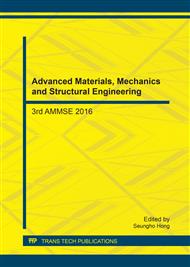p.102
p.107
p.112
p.117
p.123
p.129
p.135
p.141
p.149
Influence of Synthesis Parameters on the Microstructure and Mechanical Property of Thermoplastic Starch
Abstract:
Thermoplastic starch was prepared via compression molding in a stainless steel mold having dimensions of 150 mm x 150 mm x 2mm. Thermoplastic starch was prepared by varying the compression temperature, compression pressure and duration of compression. The starch was extracted from bitter cassava (Manihot esculenta crantz), Datu 1 variety. Tensile properties of the material were found to be dependent on the specific conditions at which molding was done. Factorial analysis showed a significant effect of the temperature-pressure interaction on the tensile strength of thermoplastic starch at 95% confidence level. Thermoplastic starch prepared using the compression molding parameters of 105°C and 6.89 MPa (1000 psi) compression pressure exhibited the highest tensile strength of 464.88 kPa. However, using the molding parameters of 105°C and 6.89 MPa (2000 psi) compression pressure exhibited the lowest tensile strength of 416.64 kPa. Introduction of gelatinizing agents and compression molding up to 105 °C and 13.79 MPa (2000 psi) has partially caused the transformation of the microstructure of starch to a more amorphous state. This is shown by the disappearance of peaks at diffraction angles (2θ) of 12.45° (d1 = 0.71 nm), 14.85° (d2 = 0.6 nm), and 17.04° (d3 = 0.52 nm) and the increase in FWHM value at diffraction angle of 22.94° (d4 = 0.39 nm) from 3.05° (starch) to 11.43° (TPS).
Info:
Periodical:
Pages:
123-128
Citation:
Online since:
February 2017
Price:
Сopyright:
© 2017 Trans Tech Publications Ltd. All Rights Reserved
Share:
Citation:


